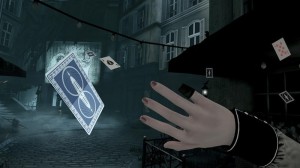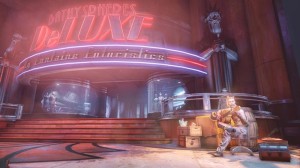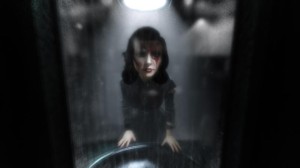Forward: This review contains spoilers for Bioshock: Infinite, Bioshock: Infinite: Burial at Sea, Episodes One and Two. Proceed with this in mind.
Bioshock: Infinite was a great game. Perhaps not the perfect game, but a truly excellent one. The story was gripping until it, figuratively, went off the rails somewhat. The pacing was good and the conclusion left it just at the right time. So, the story of Burial at Sea begs the question: Why did it have to go back to Rapture?
The answer should be that it did not need to. Bioshock: Infinite’s story, as convoluted as it could be at times, was more or less complete and required no further exploration. Bringing the story back to Rapture only added completely unnecessary filler to explain some of the stranger decisions that felt more akin to forcing square pegs into round holes that seemed to appear in greater numbers in the second episode.
The first episode can be summed up basically that Booker DeWitt is a horrible, horrible man. Whether it is his complete divorce from his native american heritage to become more white as he burned a tent full of squaws at Wounded Knee or his gambling and drinking addictions which lead to crippling debt to sell his only daughter to amoral scientists; any sort of ill fortune is purely of his own making and any subsequent punishment is duly deserved. Yet, this is not the same Booker DeWitt that players were in the original.
Apparently, after Elizabeth drowned her father at the metaphorical fork in the road which would have led him to become Zachary Hale Comstock, all the realities of Columbia simply ceased to exist. Except for one last remaining Comstock that had, after a failed attempt to pilfer another Elizabeth from another Booker, escaped to Rapture to start over, yet again, as he was before his time as Comstock.
It does make a bit of sense to see this Booker not know whom Elizabeth is until it is too late, and by then he is ultimately the metaphorical sinner in the hands of an angry goddess. It could have ended right then and there. Booker DeWitt could have easily spent his last seconds with a hole in his chest, courtesy of a Big Daddy, blood spilling out in droves as Elizabeth gives him a smirk as she carries Sally, the subject of the first episode, off into who knows where.
Sadly, this is not the case. Despite all the logic Infinite attempted to establish, Irrational breaks it in order to push the last bit of this hateful finale past the finish line. All the jargon the Luteces spout to explain Elizabeth’s vulnerability is akin to hearing excuses a child gives when a parent asks why their room has not been cleaned, despite repeated orders to do so. And it only gets worse from there.
While there were suspicions that Rapture and Columbia were connected back in the base game, Burial at Sea forces the connection with all the subtlety of a crashing train and, ultimately, makes the story of Infinite subservient to the original. Daisy Fitzroy, antagonist with a justifiable cause against the Founders of Columbia, willingly sacrifices herself so that Elizabeth can become a killer in a questionable change of character. Frank Fontaine’s two-faced revolution against Andrew Ryan was facilitated by the same elements that allowed Columbia to float in the clouds. It is all so forced to the point where facepalming would not be sufficient to describe how out of place it all has become.
The greatest shame of all is Elizabeth’s digression from the character players grew to love in the base game to this shadow of a person. Not even a shadow. Elizabeth, the playable character, became a plot device. Even more so than in the base game. And for what? So Jack, the voiceless, nameless mook from the first Bioshock game, who did not even have a name until recently, can swoop in and save the day, as Ken Levine now decreed that the good ending of the original Bioshock is canon. It is especially jarring on account that Jack has no real qualities to speak of and is best described by Benjamin Croshaw in his ‘Yahtzee goes to GDC’ video from Zero Punctuation.
And so, Burial at Sea ends, Ken Levine dissolves Irrational, and players are left with a disgusting taste in their mouths almost akin to the ending of Mass Effect 3. Thankfully, Ken Levine had the good sense not to try and fail to ape Stanley Kubrick in a hilariously botched attempt at recreating the ending of 2001: A Space Odyssey that will always be remembered as a moist fart.
As far as the gameplay goes, it is a drastic change from the original and the previous episode. Resources are scarce, Elizabeth is fragile and dies easily, and the enemies grow increasingly numerous and resistant to any sort of frontal attack. It would be especially prudent to avoid Big Daddies at all costs, as Elizabeth is simply not equipped nor capable of surviving a fight with one.
On the plus side, it does keep the tension high and for the more cautious players, there are ways to avoid detection, means to provide distraction, and the tools the players have are effective at what they do. It just seems slightly disappointing that all the amazing abilities players were given in previous games have been stripped away for but a few that work.
The best way to describe this DLC package is a rephrasing of Andrew Ryan’s tired platitude that he repeated nonstop to make some sort of point:
Bioshock Chooses.
Infinite Obeys.
Should a fan of Bioshock: Infinite purchase this DLC? Perhaps. It depends upon whether the individual preferred the original over Infinite. If one is so determined and in love with Andrew Ryan’s pseudo-utopia, based off the writings of a hack, then by all means. Those who preferred Infinite to the original would do better to simply watch a playthrough and be done with it. Or, perhaps, pretend that Burial at Sea never happened and allow Elizabeth the happy ending in Paris that she not only deserved, but earned.



